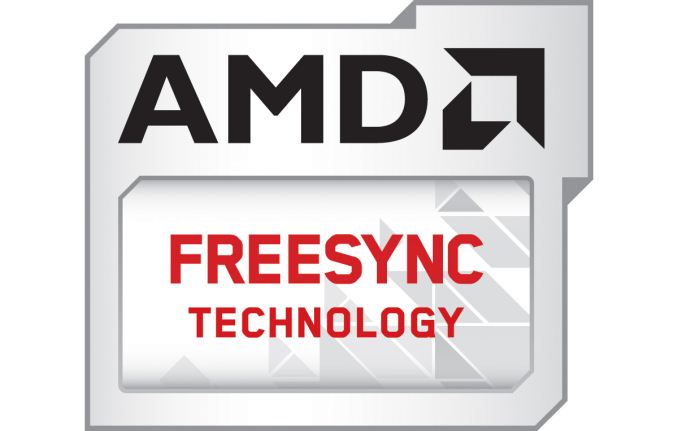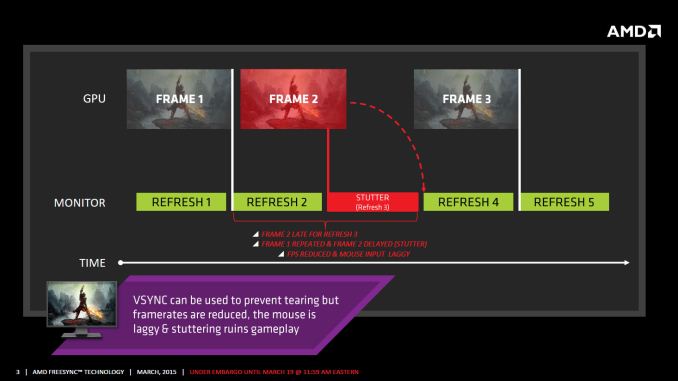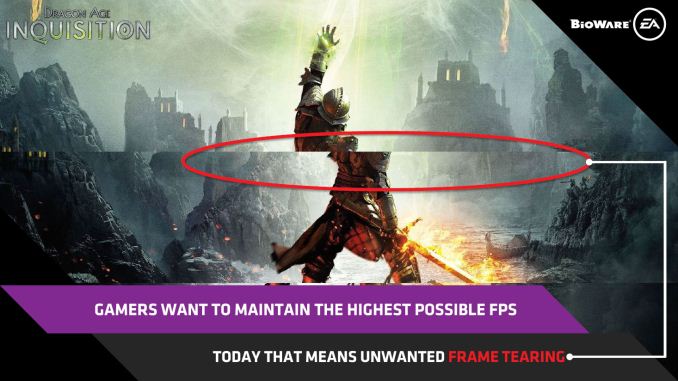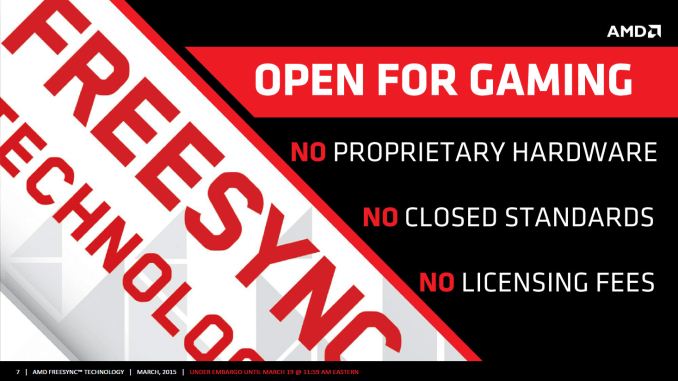The AMD FreeSync Review
by Jarred Walton on March 19, 2015 12:00 PM EST
Introduction to FreeSync and Adaptive Sync
The first time anyone talked about adaptive refresh rates for monitors – specifically applying the technique to gaming – was when NVIDIA demoed G-SYNC back in October 2013. The idea seemed so logical that I had to wonder why no one had tried to do it before. Certainly there are hurdles to overcome, e.g. what to do when the frame rate is too low, or too high; getting a panel that can handle adaptive refresh rates; supporting the feature in the graphics drivers. Still, it was an idea that made a lot of sense.
The impetus behind adaptive refresh is to overcome visual artifacts and stutter cause by the normal way of updating the screen. Briefly, the display is updated with new content from the graphics card at set intervals, typically 60 times per second. While that’s fine for normal applications, when it comes to games there are often cases where a new frame isn’t ready in time, causing a stall or stutter in rendering. Alternatively, the screen can be updated as soon as a new frame is ready, but that often results in tearing – where one part of the screen has the previous frame on top and the bottom part has the next frame (or frames in some cases).
Neither input lag/stutter nor image tearing are desirable, so NVIDIA set about creating a solution: G-SYNC. Perhaps the most difficult aspect for NVIDIA wasn’t creating the core technology but rather getting display partners to create and sell what would ultimately be a niche product – G-SYNC requires an NVIDIA GPU, so that rules out a large chunk of the market. Not surprisingly, the result was that G-SYNC took a bit of time to reach the market as a mature solution, with the first displays that supported the feature requiring modification by the end user.
Over the past year we’ve seen more G-SYNC displays ship that no longer require user modification, which is great, but pricing of the displays so far has been quite high. At present the least expensive G-SYNC displays are 1080p144 models that start at $450; similar displays without G-SYNC cost about $200 less. Higher spec displays like the 1440p144 ASUS ROG Swift cost $759 compared to other WQHD displays (albeit not 120/144Hz capable) that start at less than $400. And finally, 4Kp60 displays without G-SYNC cost $400-$500 whereas the 4Kp60 Acer XB280HK will set you back $750.
When AMD demonstrated their alternative adaptive refresh rate technology and cleverly called it FreeSync, it was a clear jab at the added cost of G-SYNC displays. As with G-SYNC, it has taken some time from the initial announcement to actual shipping hardware, but AMD has worked with the VESA group to implement FreeSync as an open standard that’s now part of DisplayPort 1.2a, and they aren’t getting any royalties from the technology. That’s the “Free” part of FreeSync, and while it doesn’t necessarily guarantee that FreeSync enabled displays will cost the same as non-FreeSync displays, the initial pricing looks quite promising.
There may be some additional costs associated with making a FreeSync display, though mostly these costs come in the way of using higher quality components. The major scaler companies – Realtek, Novatek, and MStar – have all built FreeSync (DisplayPort Adaptive Sync) into their latest products, and since most displays require a scaler anyway there’s no significant price increase. But if you compare a FreeSync 1440p144 display to a “normal” 1440p60 display of similar quality, the support for higher refresh rates inherently increases the price. So let’s look at what’s officially announced right now before we continue.













350 Comments
View All Comments
Flunk - Friday, March 20, 2015 - link
Free Sync = Adaptive Sync + AMD GPU + AMD Drivers.Gigaplex - Thursday, March 19, 2015 - link
Adaptive Sync as part of the DP spec is optional. It's not required for certification.JonnyDough - Monday, March 23, 2015 - link
Yep.FriendlyUser - Thursday, March 19, 2015 - link
Read the article. Freesync monitors are less expensive. Plus, they have a much better chance of getting Intel support or even Nvidia support (wanna bet it's going to happen? they're simply going to call it DisplayPort variable refresh or something like that...)imaheadcase - Thursday, March 19, 2015 - link
Intel support? I doubt you will find anyone buying these with a intel GPU. Why would nvidia support it with its investment already in Gsync..with new Gsync monitors IPS shipping this month? Makes no sense.testbug00 - Thursday, March 19, 2015 - link
Laptop displays. Laptop displays. Laptop displays. Being able to lower the refresh rate when you don't need it higher is something nearly every laptop could use. Currently there are no implementations of Freesync/Async that go down to 9Hz, but, well... That's power savings!Zan Lynx - Wednesday, March 25, 2015 - link
http://www.intel.com/content/dam/doc/white-paper/p...Refresh rate switching is definitely part of it.
And tablet and phone chipsets go as far as having no refresh at all. The display only updates when there is a new frame. The tablets even use a power-saving simple frame buffer / LCD driver and turn off the render hardware entirely.
anubis44 - Tuesday, March 24, 2015 - link
nVidia will buckle. It's inevitable. They can't stand against the entire industry, and AMD has the entire industry behind them with this. Jen Hsun knows he's already lost this battle, and he's just out to milk G-Sync for whatever he can get, for as long as he can get it. It's only a short matter of time before somebody hacks the nVidia drivers and makes them work with FreeSync, a la the old custom Omega ATI drivers. How appealing will it be to pay extra for G-Sync monitors once custom nVidia drivers exist that work with the much wider range of FreeSync monitors?chizow - Tuesday, March 24, 2015 - link
LOL, yes the thought of having to use a hacked driver to use an inferior solution leading to Nvidia reversing course on G-Sync is a thought only an AMD fan could possibly find palatable.G-Sync isn't going anywhere, especially in light of all the problems we are seeing with FreeSync.
Black Obsidian - Thursday, March 19, 2015 - link
Of course FreeSync is better than Gsync because it's open.Royalty cost to GPU-maker to support FreeSync is literally $0. That makes future Intel or nVidia GPUs a driver update away from supporting FreeSync. Compare to Gsync, at a royalty cost greater than zero, assuming nVidia would license it at all.
Scaler cost to LCD-makers to support FreeSync appears to be a maximum of $50 now, quite likely $0 in the long run as it becomes a default feature in all scalers. Compare to Gsync at $200+.
Take off your fanboy blinders for a moment. Capabilities being equal (as they so far seem to be), a royalty-free solution that's supported by default on future standard hardware is clearly better than a royalty-encumbered solution that requires costly additional hardware, no matter which team is supporting which one.